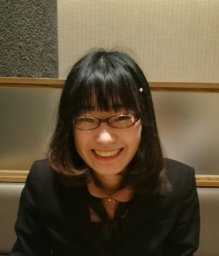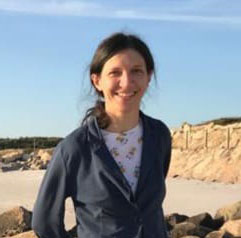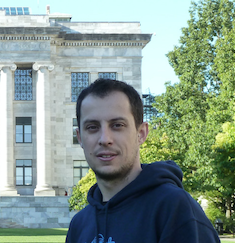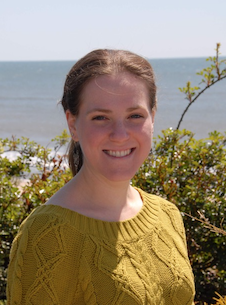2025 Goldberg Fellows
Jonathan Markert, Ph.D.
Farnung Lab
The enzyme SETD2 deposits the histone mark H3K36me3, which is found throughout gene bodies and is required for maintaining chromatin architecture, gene regulation, and mRNA splicing. As the main enzyme responsible for H3K36me3 deposition, it is unsurprising that mutations or loss of function in SETD2 are common in various carcinomas and disease. Despite its clinical significance, the mechanistic basis of SETD2 function remains largely unexplored. In my postdoctoral research, I have discovered that SETD2 relies entirely on the RNA polymerase II transcription elongation machinery to deposit H3K36me3. My findings have revealed that RNA polymerase II manipulates the nucleosome to facilitate SETD2 recruitment and recruits additional factors that directly alleviate SETD2 auto-inhibition. My ongoing research in the Farnung lab continues to investigate the detailed activation mechanisms of SETD2, providing explanations for how H3K36me3 is incorporated into gene bodies and how this histone mark regulates downstream processes.
Felix Kraus, Ph.D.
Harper Lab
Lysosomes play a crucial role in degrading and recycling cellular materials in eukaryotic cells, functioning as central hubs for lipid metabolism and nutrient sensing. Dysfunctions in lysosomal processes are linked to over 50 rare genetic lysosomal storage diseases (LSDs) affecting diverse biological systems and increasing the risk of neurodegenerative diseases like Parkinson's Disease (PD).
In my research in the Harper Lab, I am aiming to characterize the molecular signatures of LSDs and the cellular responses of lysosomal dysfunction using unbiased multiomic approaches. For example, we recently demonstrated that dysregulation of cholesterol transport disrupts cellular iron homeostasis with cascading effects on mitochondrial respiratory chain complexes, underscoring the complex interplay between lysosomal function and broader cellular health.
I am now focusing on lysosomal mutants that increase the risk of PD, and utilizing stem-cell derived neuronal models, along with proteomics and microscopy techniques, I intend to investigate the consequences of LSD-PD mutations as well as to explore the molecular and spatial dynamics of cellular compensatory response processes. Through a deeper understanding of the molecular underpinnings of LSD-PD, I hope to pave the way for more targeted and effective treatments for neurodegenerative diseases associated with lysosomal dysfunction.
2024 Goldberg Fellows
Taciani Magalhaes, Ph.D.
Salic Lab
Wnt morphogens play critical roles in development, regeneration, and cancer by activating the Wnt signaling pathway. However, it is still unknown how Wnt signals are transmitted and received, given their strong lipid-dependent membrane attachment. My research in the Salic Lab aims to understand the release and spread of Wnt ligands from producing cells to activate Wnt signaling in the responding cells. By using cell-based and biochemistry assays, we recently discovered that two classes of secreted proteins, belonging to the Secreted Frizzled-Related Protein (SFRP) and Wnt Inhibitory Factor 1 (WIF1) families, can specifically release Wnts from cells, forming complexes that are highly active in triggering the Wnt pathway. Currently, we are investigating the mechanisms behind this network of extracellular lipid-dependent carriers. Understanding this system is crucial for identifying novel targets to correct pathological signaling and developing strategies to obtain highly active Wnt preparations for regenerative medicine.
2023 Goldberg Fellows
Melissa Hoyer, Ph.D.
Harper Lab
Disease mutations in the quality control pathways of a neuronal cell are often the hallmarks of neurodegenerative disease. When the functional compartments of the cell (organelles) become damaged they are marked by the quality control pathway (autophagy) and then the tagged organelles are degraded at the recycling center of the cell (lysosome), but what happens when lysosomes themselves become damaged? During my postdoctoral work in the Harper lab, we directly addressed the mechanisms by which damaged lysosomes are recognized and ultimately degraded by healthy lysosomes through autophagy. It’s also important to keep in mind that organelles can sometimes perform exciting new functions. For instance, in my PhD work, I discovered a protein tethering complex that regulates contact between the endoplasmic reticulum (ER, the site of protein synthesis, lipid synthesis and calcium storage) and endosome budding domains (the main site of signaling receptor cargo sorting in the cell) and this complex regulates the timing of budding domain fission and signaling receptor cargo sorting. My future goal is to continue studying cell biology pathways in human cells and neurons where I will merge my skillsets in assessing the autophagy pathway and monitoring ER dynamics to specifically interrogate the cell process of “ER-phagy” where tiny pieces of the ER are turned over through autophagy.
2022 Goldberg Fellows
Nao Horio, Ph.D.
Liberles LabOlfaction plays an important role in food seeking, reproductive behavior, territorial aggression, and predator escape. In a complex environment, animals will pay attention only to particular sensory cues, and behavioral attraction can depend on internal physiology. For example, hunger is a powerful motivational state; hungry mice will use olfaction to find and locate food sources needed for survival. Recently, we identified a neuronal mechanism by which hunger selectively promotes attraction to food odors over other olfactory cues in mice (Horio and Liberles, Nature, 2021). My research in Liberles lab focuses on the neural circuitry that enhances food odor preference in fasted mice, and more generally how internal state regulates behavior.
Valentina Rossio, Ph.D.
King LabUbiquitylation regulates almost every cellular function and therefore deciphering enzyme-substrate relationships in the ubiquitin-proteasome system (UPS) is essential in understanding how cells work. Deubiquitylating enzymes (DUBs) remove ubiquitin from proteins, thereby controlling their stability or activity. Because the UPS is dysregulated in human diseases, DUBs are being explored as potential drug targets. The human genome encodes around 100 DUBs. While some DUBs are well-characterized, others have few known substrates. My research in the King lab aims to understand the mechanisms that govern the specificity of these enzymes. By using a proteomic approach, developed in collaboration with the Gygi lab, we have identified a wide range of DUB substrates that we are using to understand the principles governing DUB specificity.
2021 Goldberg Fellows
Miguel Prado, Ph.D.
Finley Lab
My main project in the Finley lab (HMS – Cell Biology Department) seeks to explain how cells transform into highly differentiated states by remodeling their protein and organelle content. This process is exemplified by erythropoiesis, where human hematopoietic stem cells (HSC) differentiate into mature red blood cells (RBC). During this process, the proteome is completely remodeled, from thousands of different proteins expressed in HSC to a simpler proteome in RBC, where a remarkable 98% of the soluble protein content is hemoglobin. Working together with the Gygi (HMS) and Fleming (BCH) labs, we are aiming to move towards a comprehensive understanding of this degradative program by studying how critical components of the ubiquitin-proteasome system triggers this process. One example is UBE2O, an E2/E3 hybrid enzyme that is upregulated during terminal erythroid differentiation. Employing multiple proteomic techniques, we were able to identify UBE2O as a critical component of the machinery in charge of configuring the proteome during erythropoiesis by targeting, among many others, ribosomal proteins for proteasomal degradation (Nguyen*, Prado* at al., Science, 2017). Altogether, we are working to demonstrate that global proteome remodeling is a fundamental new function of the ubiquitin pathway.
Alison Ringel, Ph.D.
Haigis Lab
Even though cancer incidence increases dramatically with age, very little is known about how aging pathophysiology affects tumorigenesis beyond the increase in mutational burden over time. The immune system is especially vulnerable to functional decline with aging, including CD8+ T cells that can selectively kill tumor cells by recognizing features that differ from normal tissue. Surprisingly little is known about how the aged immune system interacts with developing tumors. My research in the Haigis Lab focuses on the discovery of molecular mechanisms dysregulated within aging tumors that regulate local immune responses and tumor progression.

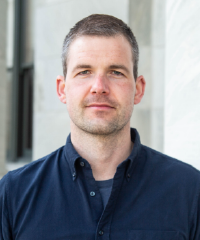
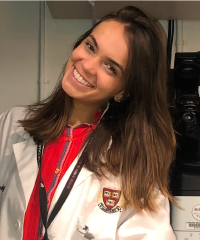
%202022.jpg)
